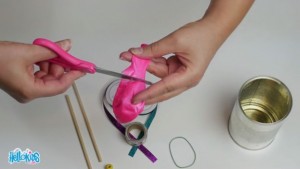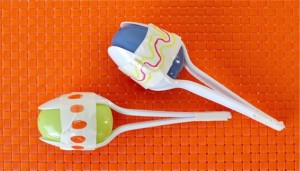
Music & Speech Therapy: Building Language while Crafting Instruments
Music & Speech Therapy: Building Language while Crafting Instruments
Music & Speech Therapy –
There are several ways in which music can be used to build speech and language skills (read about it here). Music allows a speech therapist to bring in a lot of fun into the session. The right song (or rhyme) can also bring enjoyment into the session (read about 8 fun movement songs here) while building skills. Music can also be brought into the session though musical instruments and toys. These can be bought from toy stores. However, creating a toy instrument can bring its own element of fun!
Why use music in speech therapy?
Music makes the therapy fun and engaging. It adds another dimension to the session, which makes learning language and speech a tad bit easier for the individual with speech and language delays/ disorders. It reduces the pressure to perform (to speak or use language) since music destresses the child or adult.
Teens and adults in speech therapy would typically also enjoy listening to music and hence perform better.
Science tells us that music has a positive effect on the development of the brain, language learning as well as reading skills in children. For adults with speech and language disorders music makes learning more memorable or relatable while keeping the sessions more relaxed/playful.
Playing music on an audio/music device (such as a computer, tablet or phone that can run a music app off the internet) will allow access to a lot of songs quite easily.
Why get crafty, you ask?
Well, it is a wonderful way to enhance a child’s skill at many different levels. It can expand or strengthen a child’s speech-language skills, his/her attention and concentration, listening, and imitation skills. Additionally, you can customize the activity to suit a child’s liking. For example, build a blue colored banjo for a child who loves blue!
This article will talk about how to create three different musical instruments. The activities would require some preparation and planning, but it will be well worth it! Let’s first talk about how you can get your child involved as well as build his language skills.
How to get the child involved
- Allow your child to participate in each step of the activity chosen. The steps for all the activities are simple and short, making it quite possible to have the child participate easily.
- Alternately, you can model a part of the activity and the child can follow and carry out the same. You can place one or two of them while giving the child the chance to follow your lead and place the remaining two or three.
- Another way to have the child involved in the activity is by alternating steps of the sequence (within the activity). For this, make sure a visual sequence is available (that will illustrate clearly what the sequence of events for building the instrument). Take time to go over the visual sequence chart with the child, first. Then take turns and carry out the steps to create the instrument (together).
- For slightly advanced learners, you can keep two sets of the materials ready. This will allow you and the child to build the instrument in parallel. Each one of you will make your own instrument. You will be a good model for the child but allow him to be completely independent along all the steps.
How to build language:
- Language building can be present throughout the task. Make sure to use a visual /picture sequence card to prepare the child for the many steps to create/build the instrument. This is a wonderful time to introduce the child to any new words s/he may not know.
- Use a lot of words relating to time and sequence. Words such as – ‘first, next, last’ or ‘now- later’ can be emphasized throughout the activity. Let the activity create opportunities for use of such language.
- The activities can allow you to generalize a lot of language the child may already know. For example, ‘Waiting’ can be generalized across several activities and steps such as ‘waiting for glue to dry’, ‘waiting for paint to dry’ or ‘waiting for mummy to tape the egg’ etc.
- Allow the child to learn to listen and follow instructions. You can direct simple instructions to the child, such as – “Cut the balloon here (on a marked portion).” and provide the items to allow the child a chance to follow the instruction.
- The child can learn a lot of receptive skills through the activities, such as ‘Understanding item by their use, colors of items, choosing a named item from a group’ etc. You can lead the child to learn the following. For example, if you want the child to know that you ‘cut with scissors’, then during the drum making activity – you can tell him “Now we will be cutting the balloon….can you pick up what we can use for cutting?”. This can encourage the child to pick up the scissors with your guidance.
- To make the activity more for social learners, ensure that you create independent instruments but share few materials. For instance, while creating the maracas, each child should get their own eggs, but the tape can be common. This would allow the child to learn social communication including – requesting, turn taking, waiting, initiating relevant conversation etc.
- Work on recall by allowing the child to talk about how they created the instrument.
Now, let’s get crafty. See how to make 3 different instruments with an outline on how to ensure you are building skills:
-
Rubberband Banjo.
- What to prepare? 4 to 5 Rubber bands, a metal lid/cap (mid-sized), glue, ice-cream stick, paints and stickers (or any embellishment).
- What to do? Place two or three rubber bands around the lid, leaving 2 to 3 cm between each other. Hold each rubber band in place by gluing them to the top of the lid. Glue an ice cream stick to one side of the top of the lid (as a handle for the banjo). Use embellishments (stickers) and color to customize the banjo.
- How to get your child involved? Placing the embellishments can be the most fun part of the activity. Let the child be creative during this time. Placing the rubber bands may require some attention (and attention to detail). Assist the child through this, as the rubber bands can slip off quite easily.
- Speech / Language word suggestions: Lid, top/bottom, Around / next to, glue/stick, dry/wet, ice cream stick, handle, the name of colors/ stickers, banjo, music.
-
Bottle drums.
- What to prepare? Empty cylindrical (sturdy) plastic or metal bottle with a medium sized mouth, 2 balloons, scissors, strong thick tape
- What to do? Remove the cap of the empty bottle. Snip off a little of the bottom (at the opening) of the balloon. Stretch the intact part of the balloon tightly over the mouth of the bottle. Tape the balloon on to the bottle. Make sure that it is stretched well. Now it is ready to play.
- How to get your child involved? Let the child build attention and concentration by cutting the balloon or taping it to the bottle.
- Speech / Language word suggestions: Drum, bottle, cap, on / off, balloon, cut, stretch/pull, tight/loose, tape, music.
-
Kinder joy Maracas
- What to prepare? 2 plastic spoons (that can fit the kinder egg in it), 1 kinder joy egg, Tape, ghungrus (or small metal beads), Paint and stickers (or other embellishments)
- What to do? Place the ghungrus into the egg and tape it closed. Now, place the in between the two plastic spoons (see the picture). Tape them together tightly. Now, the macaras as ready to be personalized with paint and stickers. Let the child be creative here, also.
- How to get your child involved? Allow the child to build listening, attention, and concentration by placing the ghungrus in the kinder joy egg, taping the egg together and taping the spoons around it.
- Speech / Language word suggestions: Maracas, Egg, inside / outside, less / more, ghungrhu, close/open, tape, spoons, music
Let us know what you thought of these instruments and what language you could build through them. We would love to hear from you.
***
Subscribe to us to receive our latest articles in your inbox.
***
- What is speech therapy and what Speech Therapist Do? - December 22, 2022
- 5 Simple Ideas to Make Flashcards Fun - June 28, 2018
- Should I use ‘NO’ with my child? - June 24, 2018





Leave a Comment
(0 Comments)